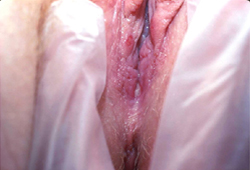Resumen
Definición
Anamnesis y examen
Principales factores de diagnóstico
- presencia de factores de riesgo
- disuria (en mujeres)
- linfadenopatía
- úlcera genital
- úlcera oral
- fiebre
Otros factores de diagnóstico
- sensación de hormigueo
- cefalea/meningitis aséptica
Factores de riesgo
- infección por VIH (factor de riesgo para enfermedad clínica)
- uso de medicamentos inmunosupresores (factor de riesgo para enfermedad clínica)
- sexo femenino (factor de riesgo para seropositividad)
- raza negra (factor de riesgo para seropositividad)
- aumenta con la edad (factor de riesgo para seropositividad)
- comportamiento sexual de alto riesgo (factor de riesgo para seropositividad)
- no usar condones (factor de riesgo para seropositividad)
Pruebas diagnósticas
Primeras pruebas diagnósticas para solicitar
- reacción en cadena de la polimerasa del VHS (PCR)
- cultivo viral
Pruebas diagnósticas que deben considerarse
- serología específica de tipo basada en glucoproteína G (gG1 y gG2)
Algoritmo de tratamiento
Afectación del SNC: encefalitis o meningitis
afectación visceral diseminada: esofagitis, neumonitis o hepatitis
enfermedad genital: primer episodio, inmunocompetente, no embarazada
enfermedad genital: primer episodio, inmunocomprometida, no embarazada
enfermedad genital: episodio recurrente, inmunocompetente, no embarazada
enfermedad genital: episodio recurrente, inmunocomprometida, no embarazada
enfermedad genital: episodio primario o primero, embarazo
enfermedad genital: episodio recurrente, embarazo
enfermedad de la cavidad oral: primer episodio, pacientes inmunocompetentes
enfermedad de la cavidad oral: primer episodio, pacientes inmunocomprometidos
enfermedad de la cavidad oral: episodio recurrente, pacientes inmunocompetentes
enfermedad de la cavidad oral: episodio recurrente, pacientes inmunocomprometidos
enfermedad genital: paciente sexualmente activa o con recurrencias graves frecuentes, inmunocompetente, no embarazada
enfermedad genital: embarazo
enfermedad de la cavidad oral: pacientes con recurrencias graves frecuentes, inmunocompetentes
enfermedad de la cavidad oral: pacientes con recurrencias graves frecuentes, inmunocomprometidos
Colaboradores
Autores
Benjamin D. Lorenz, MD
Assistant Professor
Division of Hospital Medicine
MedStar Georgetown University Hospital
Washington
DC
Divulgaciones
BDL declares that he has no competing interests. Since completing the 2024 review, BDL has become an employee of Moderna and has resigned as a contributor.
Agradecimientos
Dr Benjamin D. Lorenz would like to gratefully acknowledge Dr Christine Johnson and Dr Anna Wald, previous contributors to this topic.
Divulgaciones
CJ reports funding from AiCuris; grants from Agenus, Gilead, Genocea, Sanofi, and Vical to conduct clinical research studies; and royalties from Up To Date. AW reports grants from Agenus, Gilead, Genocea, Sanofi, and Vical to conduct clinical research studies. AW receives royalties from Up To Date. AW is an NIH grant recipient (NIH AI30731 and AI071113) and a consultant for Aicuris, Eisai, and Amgen.
Revisores por pares
Giuseppe Pizzo, DDS
Associate Professor
Department of Surgical, Oncological and Oral Sciences
School of Dentistry
University of Palermo
Palermo
Italy
Divulgaciones
GP declares that he has no competing interests.
Paul Adamson, MD, MPH
Assistant Clinical Professor of Medicine
David Geffen School of Medicine
University of California, Los Angeles
Los Angeles
CA
Divulgaciones
PA declares that he has no competing interests.
Nicholas Van Wagoner, MD, PhD
Associate Professor of Medicine
University of Alabama
Birmingham
AL
Divulgaciones
NVW declares that he has no competing interests.
Agradecimiento de los revisores por pares
Los temas de BMJ Best Practice se actualizan de forma continua de acuerdo con los desarrollos en la evidencia y en las guías. Los revisores por pares listados aquí han revisado el contenido al menos una vez durante la historia del tema.
Divulgaciones
Las afiliaciones y divulgaciones de los revisores por pares se refieren al momento de la revisión.
Referencias
Artículos principales
Morris-Cunnington M, Brown D, Pimenta J, et al. New estimates of herpes simplex virus type 2 seroprevalence in England: 'high' but stable seroprevalence over the last decade. Sex Transm Dis. 2004;31:243-246. Resumen
Centers for Disease Control and Prevention. Morbidity and mortality weekly report: sexually transmitted infections treatment guidelines, 2021. Jul 2021 [internet publication].Texto completo
Patel R, Kennedy OJ, Clarke E, et al. 2017 European guidelines for the management of genital herpes. Int J STD AIDS. 2017 Dec;28(14):1366-79.Texto completo Resumen
American College of Obstetricians and Gynecologists. ACOG practice bulletin no. 220: management of genital herpes in pregnancy. May 2020 [internet publication].Texto completo
British Association for Sexual Health & HIV; Royal College of Obstetricians and Gynaecologists. Management of genital herpes in pregnancy. Oct 2014 [internet publication].Texto completo
Artículos de referencia
Una lista completa de las fuentes a las que se hace referencia en este tema está disponible para los usuarios con acceso a todo BMJ Best Practice.

Diferenciales
- Sífilis
- Chancroide
- Linfogranuloma venéreo
Más DiferencialesGuías de práctica clínica
- Guidelines for the prevention and treatment of opportunistic infections in adults and adolescents with HIV
- BASHH summary guidance on testing for sexually transmitted infections, 2023
Más Guías de práctica clínicaFolletos para el paciente
Herpes labial
Infección ocular por herpes simple
Más Folletos para el pacienteInicie sesión o suscríbase para acceder a todo el BMJ Best Practice
El uso de este contenido está sujeto a nuestra cláusula de exención de responsabilidad